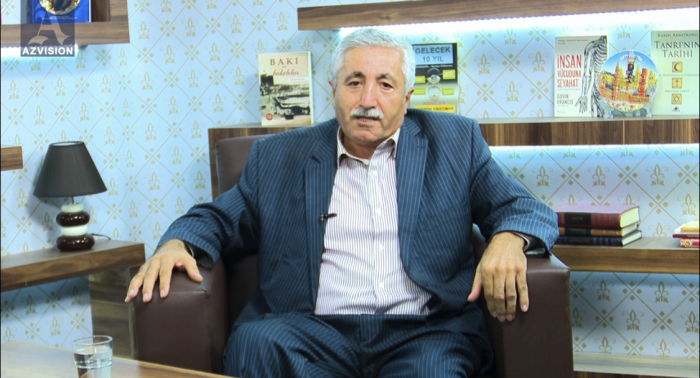One of the main culprits behind the drinking water shortage, which has swollen into a serious problem globally, is the ever-growing demand for food as the world population increases. This increases the need for water in agriculture, which is already responsible for consuming around 80% of drinking water resources.
Garib Novruzlu, deputy director at the Agricultural Research Centre under the Ministry of Agriculture, PhD in Agrarian Sciences, said in his interview to Az.Vision.azthat switching to more efficient methods may help save water and produce good results.
We have arrived late at applying modern irrigation systems in agriculture, because the entire world has now put them to use. Azerbaijan has also been taking significant steps to catch up.
‘The drip irrigation method is no longer something new. The rainfall method is mainly employed in grain cultivation, as the drip irrigation is rather complicated to apply for growing grain. It is a method more suitable for row crops, such as corn. We have been successfully employing it for around 10-15 years.
But modern irrigation methods alone are not enough, we must also introduce fundamental changes in our water infrastructure. The water is mainly delivered through earth ditches. Say, there is a kilometre from source A to point B, which would take the water 15-20 minutes at most if delivered through concrete canals, whereas it takes us an entire week for the water to reach its destination point. And that is if we are lucky enough to have rapid waters…
30 to 50 tons of water suffice to drip irrigate a hectare of land. You might ask why it varies between 30 and 50. This depends on the quantity of perennial plants and fruit trees. This may vary between 300-400 to 800-1000 per hectare. More plants per field need more water. Thus, we get the number of up to 50 tons of water to irrigate a hectare. At the same time, bedropping a hectare of a grain field requires 1200-1500 cubic meters, that is 1,500 tons of water. When we divide 1,500 by 50, we see just how big the difference is. This is why it is crucial to consume water sparingly and efficiently.
Water control is at the lowest level. All steps within the irrigation system must be planned and scheduled. The mains leading to cultivated fields must be concreted depending on what cultures are to be irrigated. This will significantly shrink water loss, delivering water to thedestination shortly.’
- What is the reason for falling so behind in applying new irrigation methods?
‘We started them 10-15 years ago, because these modern irrigation systems used to be quite expensive in Azerbaijan. Drip irrigation for a hectare of land would cost up to 2-3 thousand USD. But now we can easily set it up for less than a thousand per hectare.
Secondly, people were not familiar with them. They thought they were good but had no idea just how good they were. Education is very important. For instance, our Agricultural Research Institute mainly meets the local demand for original elite seeds. We also work with other agencies within the Ministry of Agriculture to raise awareness among farmers. There are such issues of national and global importance that cannot be commissioned to voluntary work.
Government policy has seen substantial changes in the subsidy rules. For example, a farmer receives 200 manats as subsidy if they choose to cultivate plant A but will receive 1,000-2,000 if they employ the modern drip system for irrigation. The state is providing subsidies up to 8,000 manat from May this year to May 2024 for cultivating certain plants. This method is widely encouraged.
The Arab countries are some that suffer the most from water scarcity. But they have taken their measures and employed drip and other modern irrigation systems. They can meet the domestic food demand through their own production. They have been using the most innovative methods under the harshest conditions. Efficient methods can indeed produce great results.’
- Some experts insist that countries that suffer from water scarcity should cultivate less water-dependent cultures. What is your take on this? What direction could be interesting for Azerbaijan?
‘Firstly, there is no other plant that can replace wheat both in and outside Azerbaijan. Maybe there will be one in 50 to 100 years, but it seems unrealistic for now. This does not, however, mean that we are not working on this. Our scientific research in grain cultivation back in the ‘80s mainly focused on developing high-yield, disease-resistant intensive grain varieties. After the ‘80s, the Agricultural Research Institute has been working on developing salt- and drought resistant varieties with state support. We have achieved barley and wheat specimen resistant to both through research in the last 20 years. 11 barley varieties cultivated at the Agricultural Research Institute have been state registered, which translates to state permission to plant and cultivate them throughout the country.
If you plant one of those, take ‘Karabakh-22’, in terrains with a salt content of 0.4-0.7% such as Ujar, Kurdamir, Hajigabul or Salyan, you will yield 4-5 centners more compared to other varieties. This means additional 500 kg of yield a hectare, because ‘Karabakh-22’ is the result of our research for developing salt-resistant crops. It is included in the state register and is cultivated on around a hundred thousand hectares of land throughout the country. No one can dictate what crop to plant to a farmer. They make the ultimate choice. They might try different varieties from year to year, see which ones produce the highest yield and plan accordingly.
Another drought-resistant variety is the ‘Jalilabad-19’ barley. We do not imply the perfect resistance. But if a drought-tolerant variety boosts production even by 15-20%, sometimes 30, this already is a success.
Another wheat variety is the ‘Gobustan’. The late Jalal Aliyev used to lead that project. Most farmers prefer to cultivate the ‘Gobustan’ variety on non-irrigated lands, because we can at least cover the costs while growing it.
We also have crops that produce the highest yields when irrigated, through pivot irrigation, for example. This system is operated through special technical devices programmed on a computer.’
- What about plants apart from wheat and barley, untraditional for Azerbaijan?
‘We have had some advancements, such as the state support for cultivators of millet and rice, which is included in the program for 2023-2024. Rice is rather water demanding, but it also reduces the dependence on grain to some extent. We do not consume bread with rice, to say the very least. It could replace a portion of wheat cultivation.
The most famous ‘feeds’ in animal husbandry are barley and corn. But we also need alfalfa, and a forage plant that is called the deer-alfa. It is popular in other countries and has been brought to Azerbaijan, yielding 40-50, at times even 80 tons of green mass per hectare. The cattle love feeding on it. It also plays a great role in boosting milk production and cattle weight. There are alternative fodder crops, as well.’
- What advantages might desalinating sea water and employing it in agriculture have?
‘We have been working on it, true, but I do not believe it will produce successful results. Desalinating a litre costs 2.5 USD, around 5 manats. This is the price for one litre only. Traditional irrigation requires 1,500 tons of water per hectare, which means 3,000 dollars. You must also multiply that by 4, because you need to water the crops at least 3-4 time if you are expecting a good harvest. Watering it three times comes up to 9-10 thousand USD. I am not even going into other costs, such as the fertilizers and seeds. How much would a kilo of bread cost then?
And this is the reality not only in Azerbaijan. The entire world would not be able to shoulder this burden.’
Sahil Isgandarov
More about:
















































